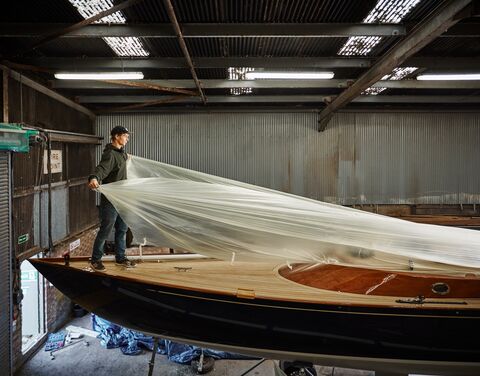
6 key steps to winterize your boat
At the end of a long summer full of the delights of sailing, the time has come to prepare your boat for the cold winter months. Correct preparation for winter storage is essential, otherwise you could be in for a nasty surprise at the start of the next boating season.
Winterizing a sailboat or motorboat takes time and effort. But it’s important. Failure to take the necessary precautions can quickly become expensive! First-time boat owners often underestimate what is required and are faced with expensive repairs in the summer. In consultation with Daniel Lindemann, our expert in boat insurance, we outline six key steps to help you winterize your boat.
Step 1: Decide where to keep you boat in the winter
There are three options:
- Indoor storage
The best option is to store your boat in a heated shed in the winter. That gives it ideal protection from wind, weather, and dampness. The only drawback is the cost.
- Storage outdoors on dry land
If you cover the boat with a strong tarpaulin, it can be left outside during the winter. Make sure the boat is stored on a rack that is high enough to prevent the cold and damp damaging the hull.
- Storage in the water
The cheapest option is to keep the boat afloat during the winter. That means you can use it anytime. But there are also some disadvantages: In a cold winter, there is a risk that freezing temperatures could cause damage. Besides, you miss out on the best time to do repairs. And every time there is a storm you’ll need to check the boat to make sure everything is okay.
To winterize your boat, it needs to be covered – regardless whether it's stored on land or in the water. Make sure that enough air can circulate under the cover, otherwise there is a risk of condensation and mold.
Step 2: Drain off all water
The main danger to boats during the winter months is that any residual water might freeze, causing the pipes and tanks to burst. To prevent that, all water must be drained out of the tanks, outside shower, boiler – and of course, the toilet. When the water has been drained, fill the tank with anti-freeze. Make sure the anti-freeze explicitly mentions that it is suitable for drinking water systems.

Step 3: Clean your boat thoroughly
Before storing your boat for the winter, it is particularly important to give the hull and underwater areas a thorough clean. You should also take this opportunity to remove any algae from the propeller and the deck. The anchor and anchor chain should also be cleaned. The quickest way to clean a boat is with a pressure washer. But please note that pressure washing may not be suitable for the hull, depending on what it is made of. Minor damage to the hull should be repaired with a special filler. The cabin can be cleaned with a general-purpose cleaner.
Draining all water is the most important step in winterizing your boat.
Step 4: Check the battery and electronics
Make sure the battery is fully charged before putting the boat in winter storage. If possible, remove the battery and connect it to a trickle charger because discharging and cold significantly reduce the battery life. If you cannot remove the battery, all circuits in the boat must be switched off during the winter.
You should also check all switches, fuses, and cables to prevent corrosion and short-circuits. Electronic appliances and their batteries should be removed from the boat. By contrast, the boat’s electronics system should be left in place.
Step 5: Take care of your boat's engine
The winter is when engines are most susceptible to rust and freezing temperatures. Therefore, it is advisable to change the engine oil and oil filters before the winter. The oil should preferably be changed while the boat is still afloat. To prevent damage to the engine, it is particularly important to make sure that the water in the cooling circuit does not freeze during the winter. Either let the water drain out or use a suitable anti-freeze.
Step 6: Make good use of the winter
Winter is the perfect time to get your boat ready for the next season. Now you can do all those (minor) repairs you've been putting off! It’s also a good time to have equipment such as fire extinguishers and life jackets serviced.





